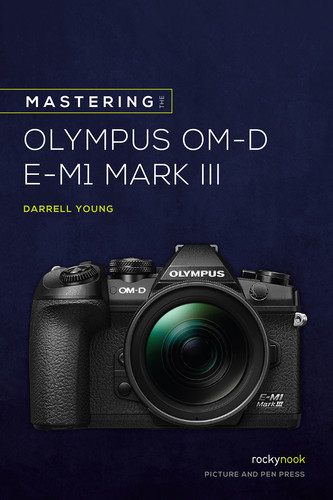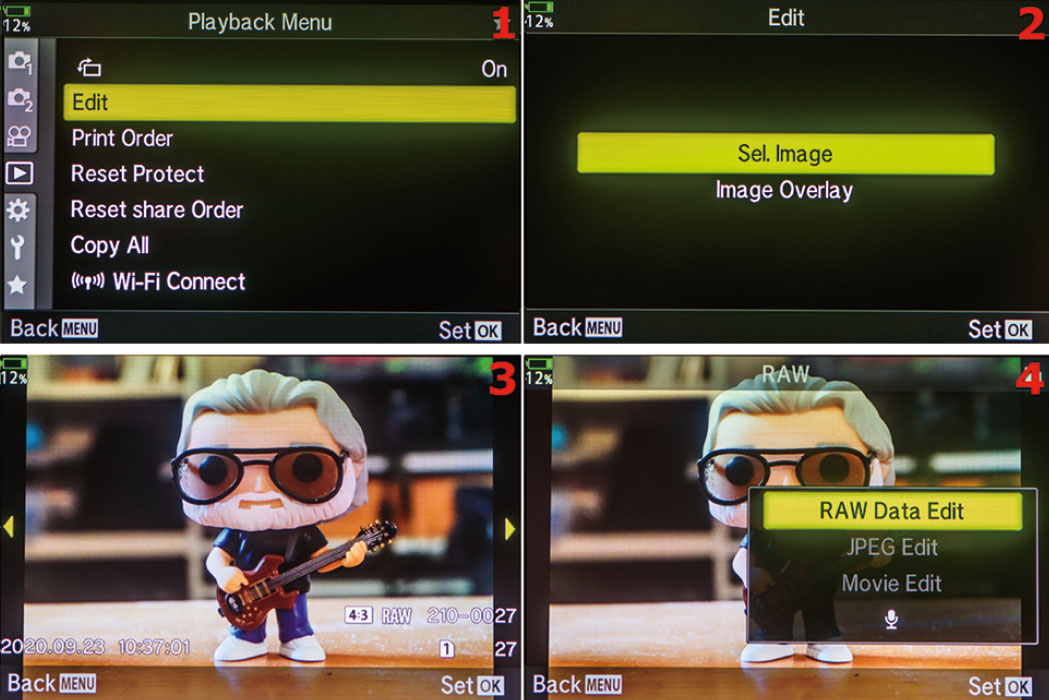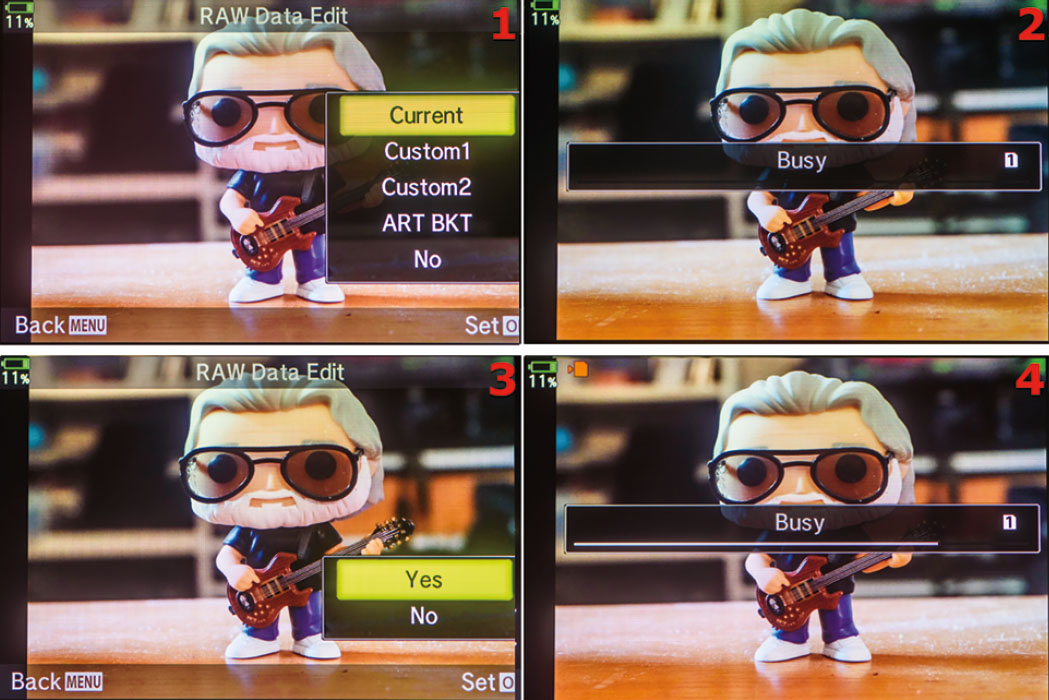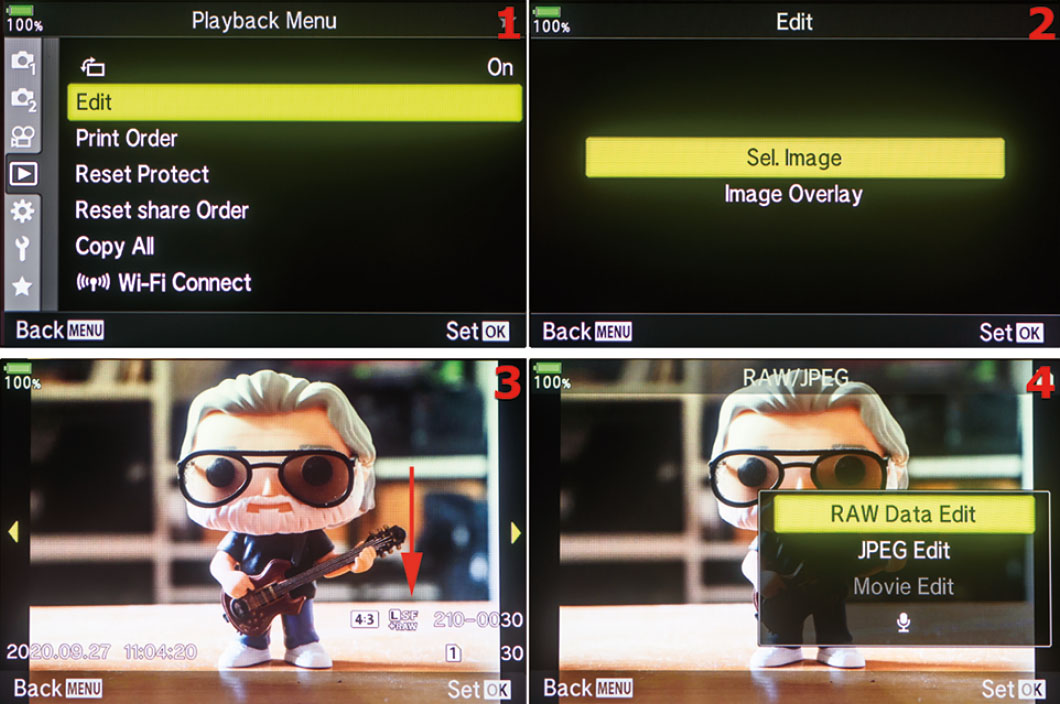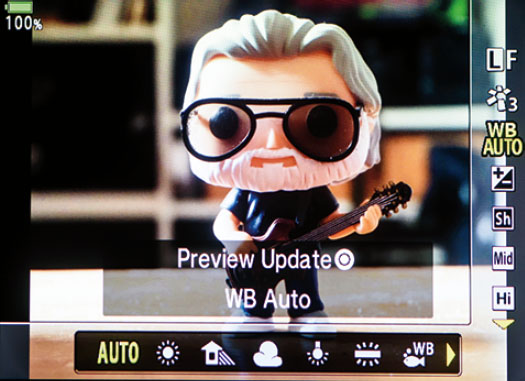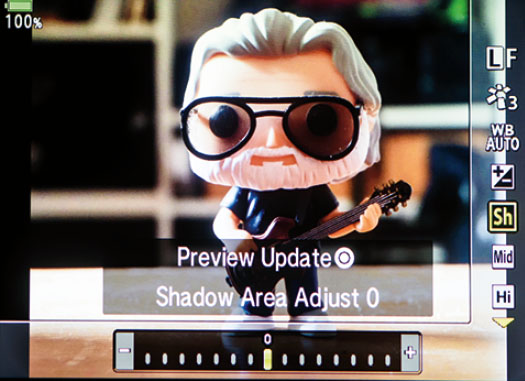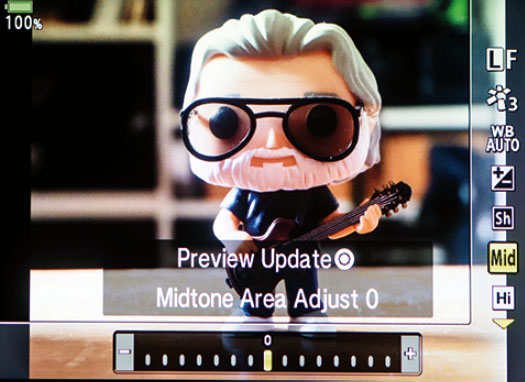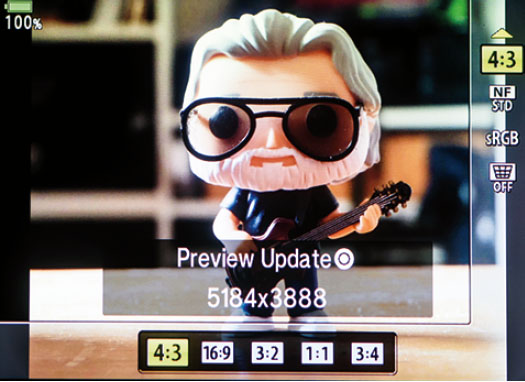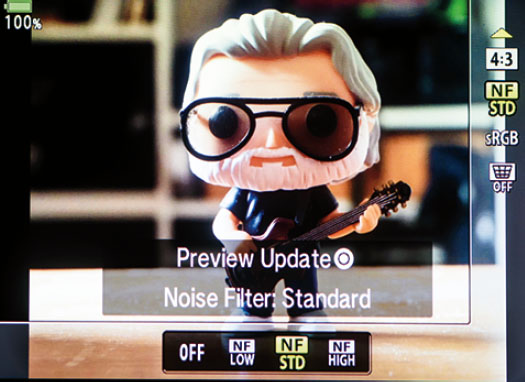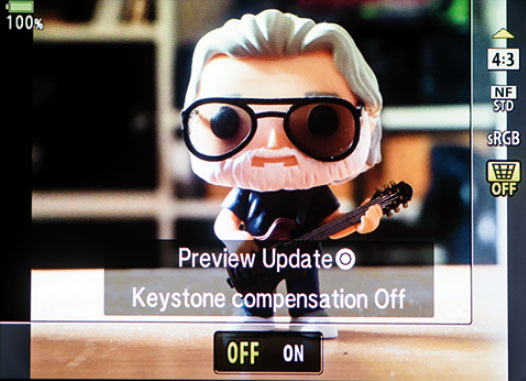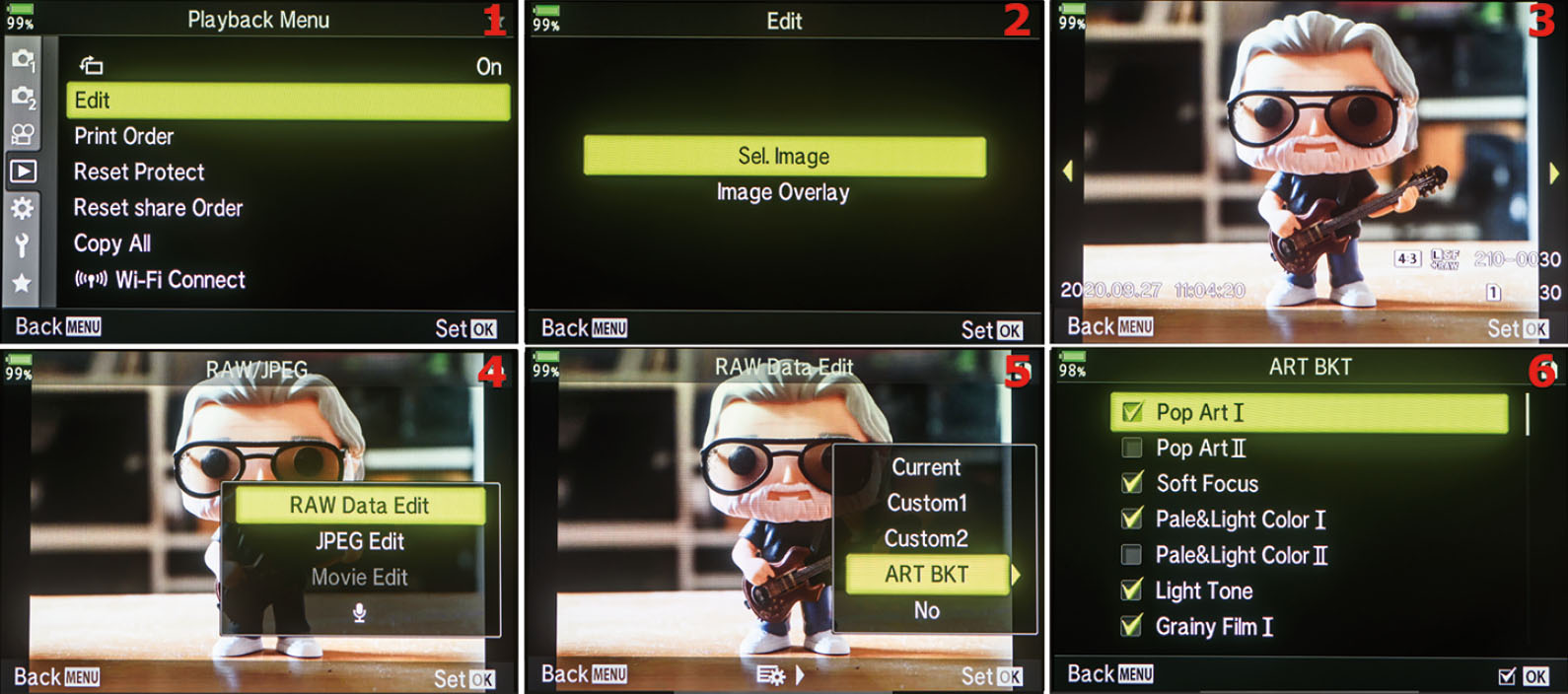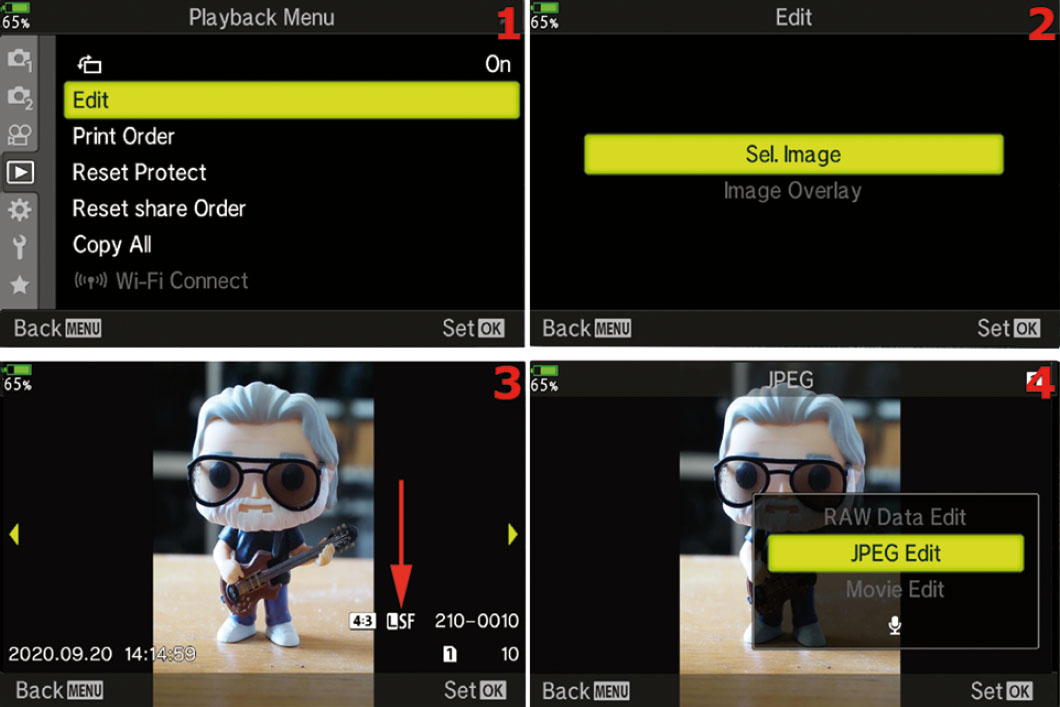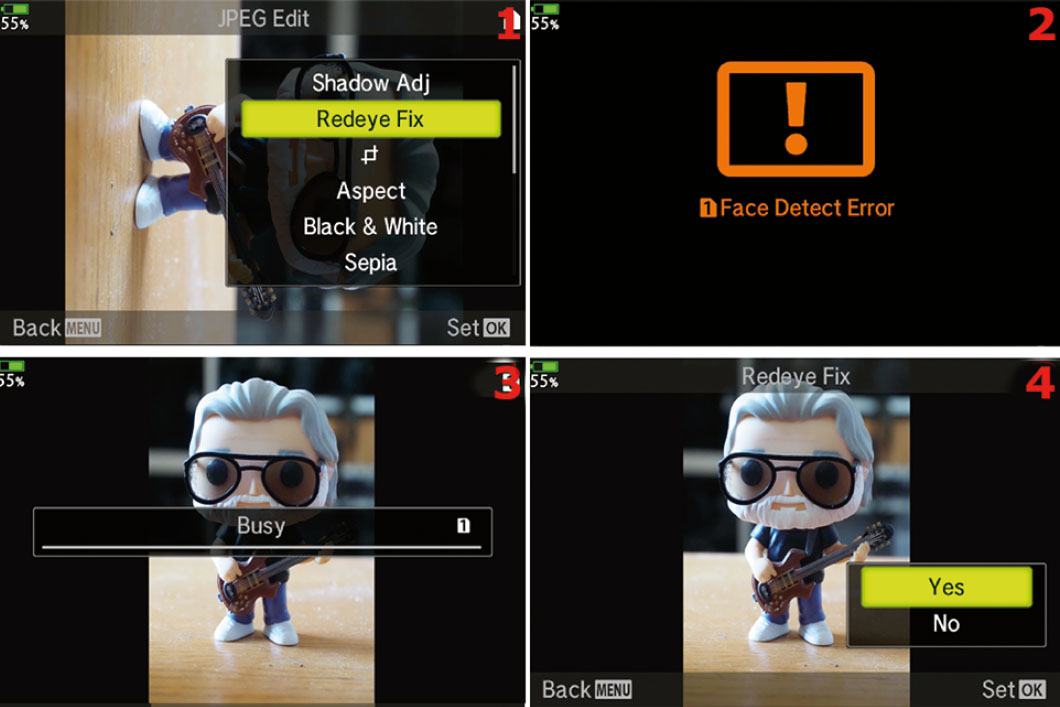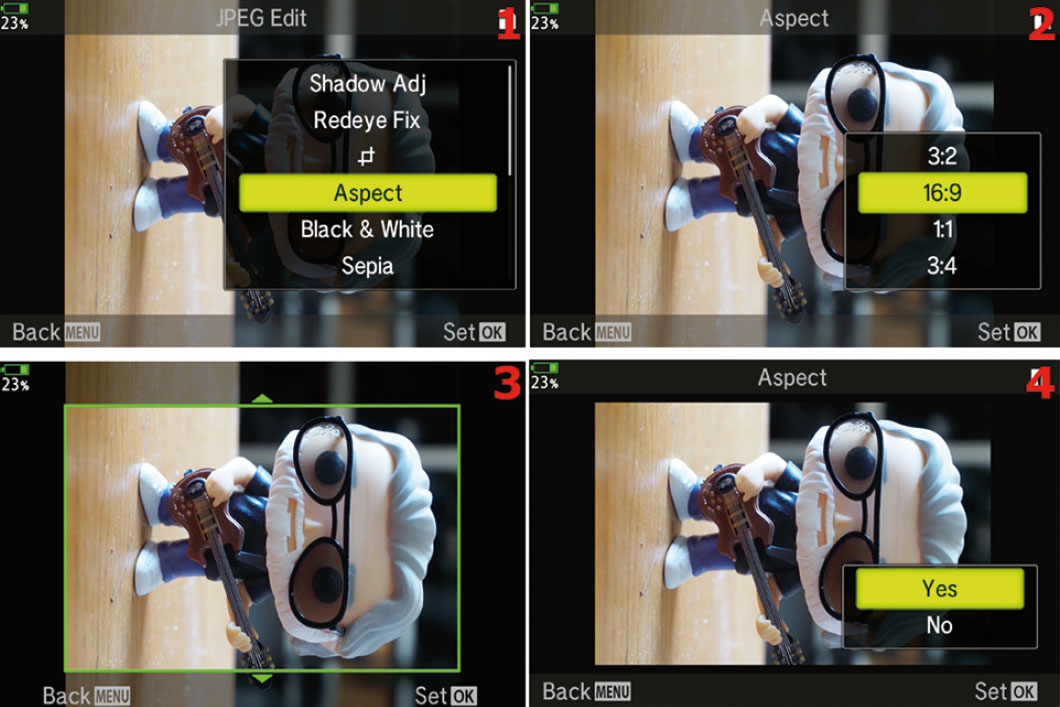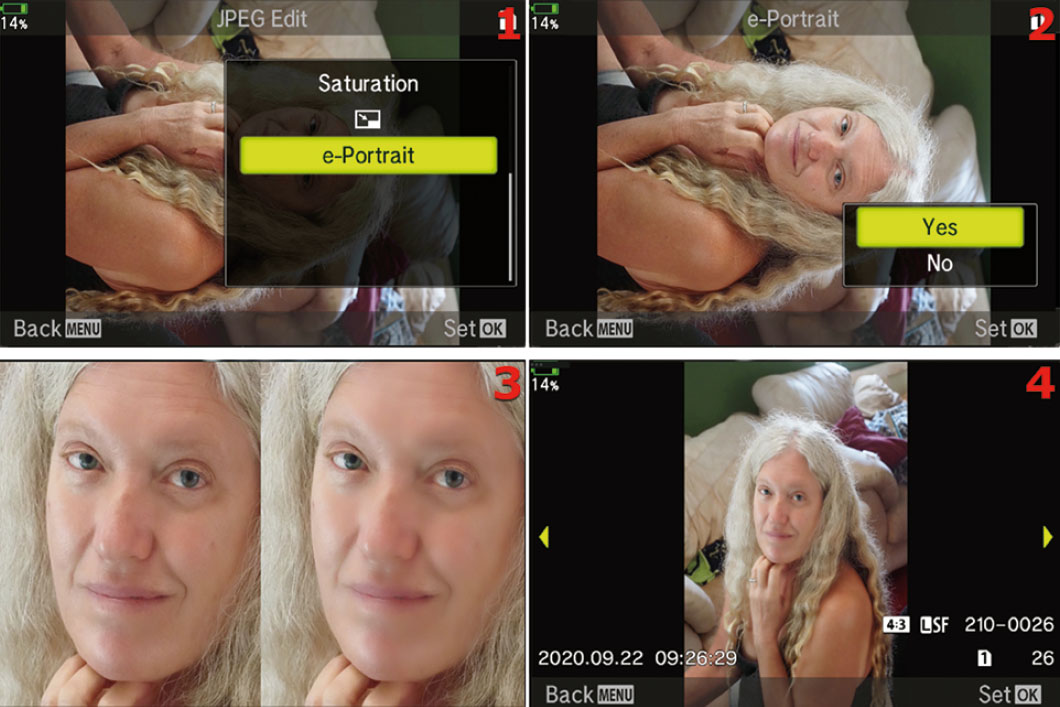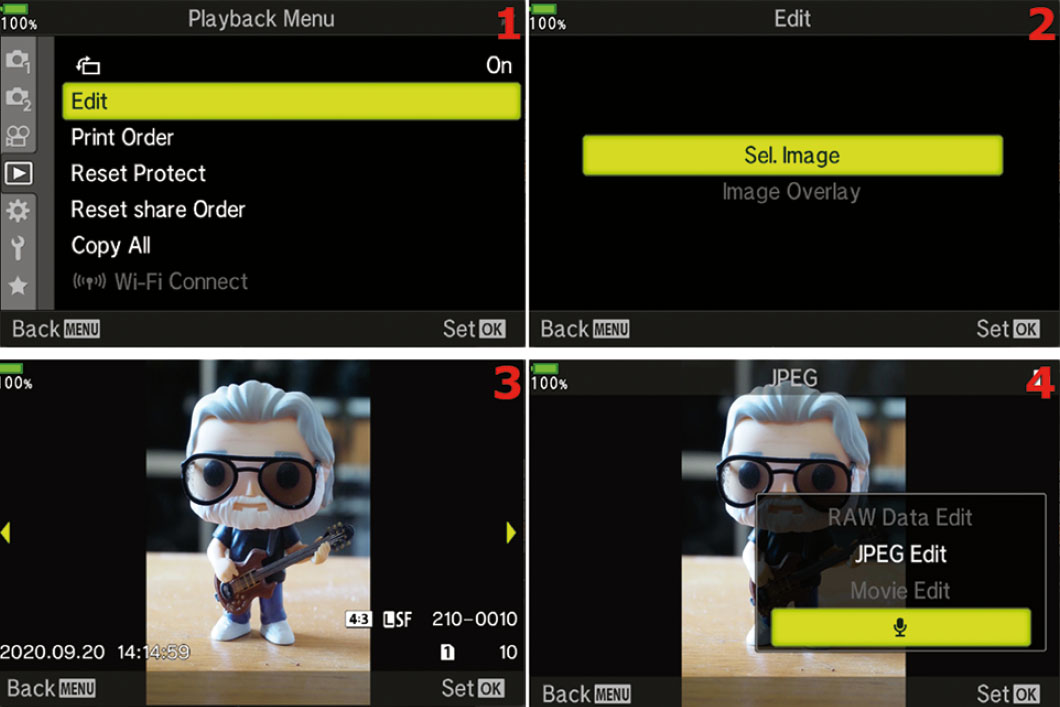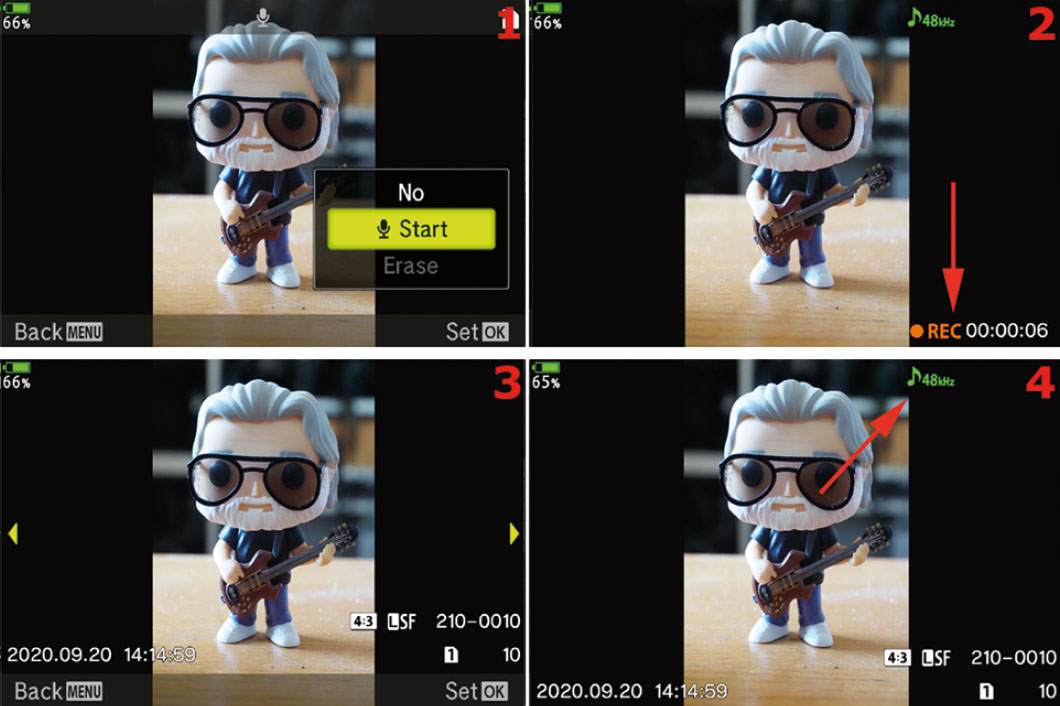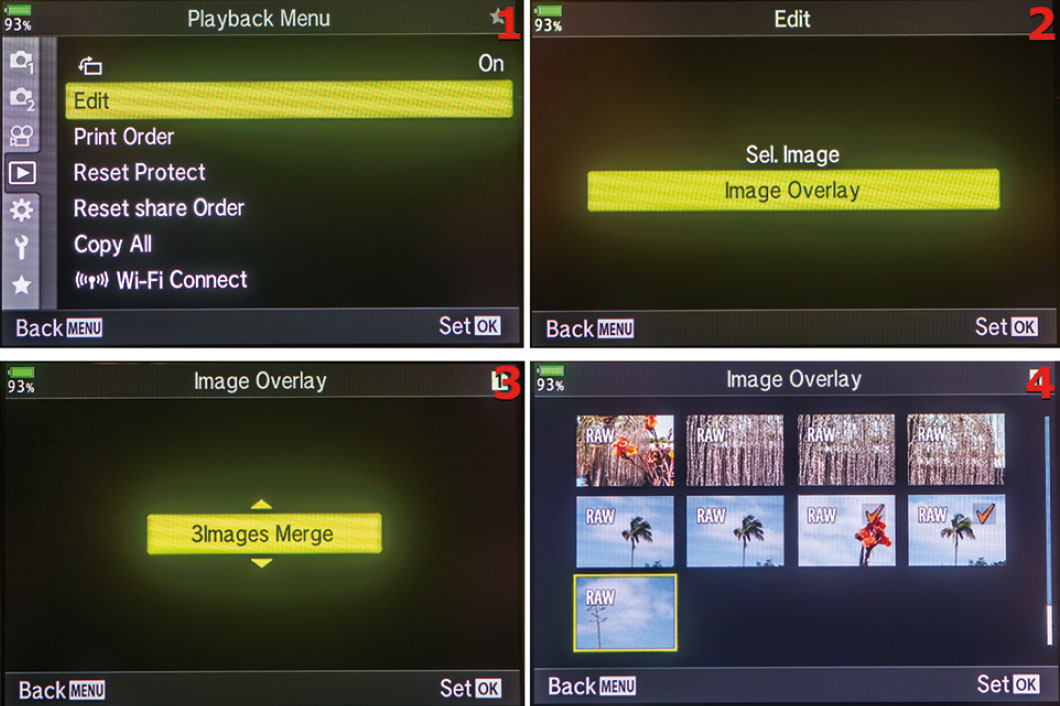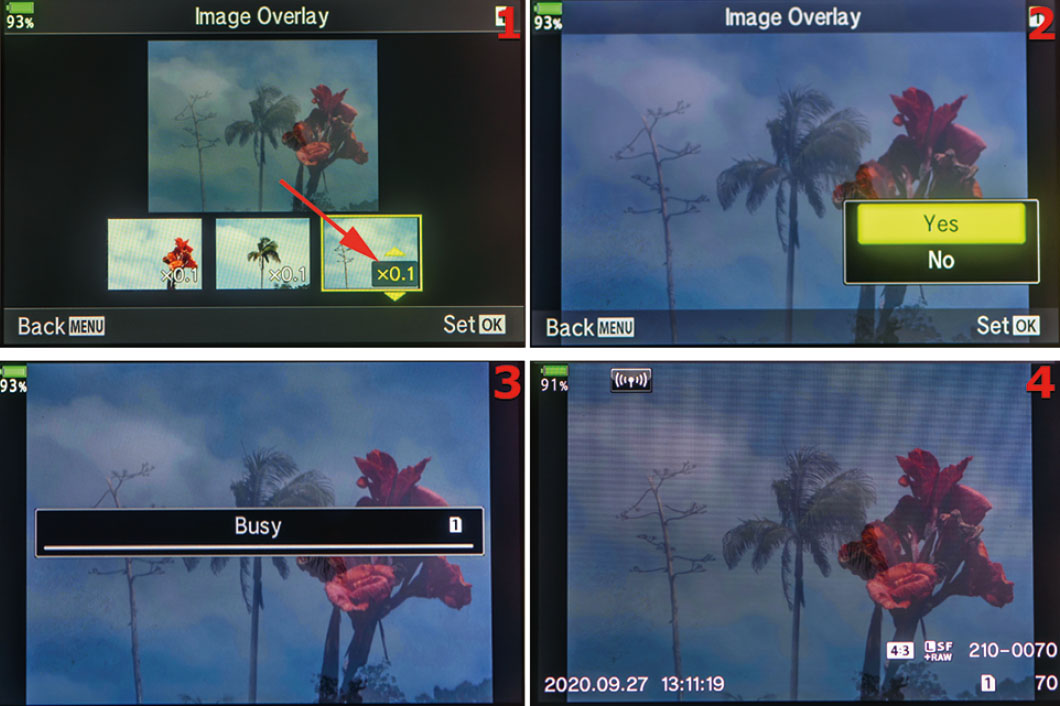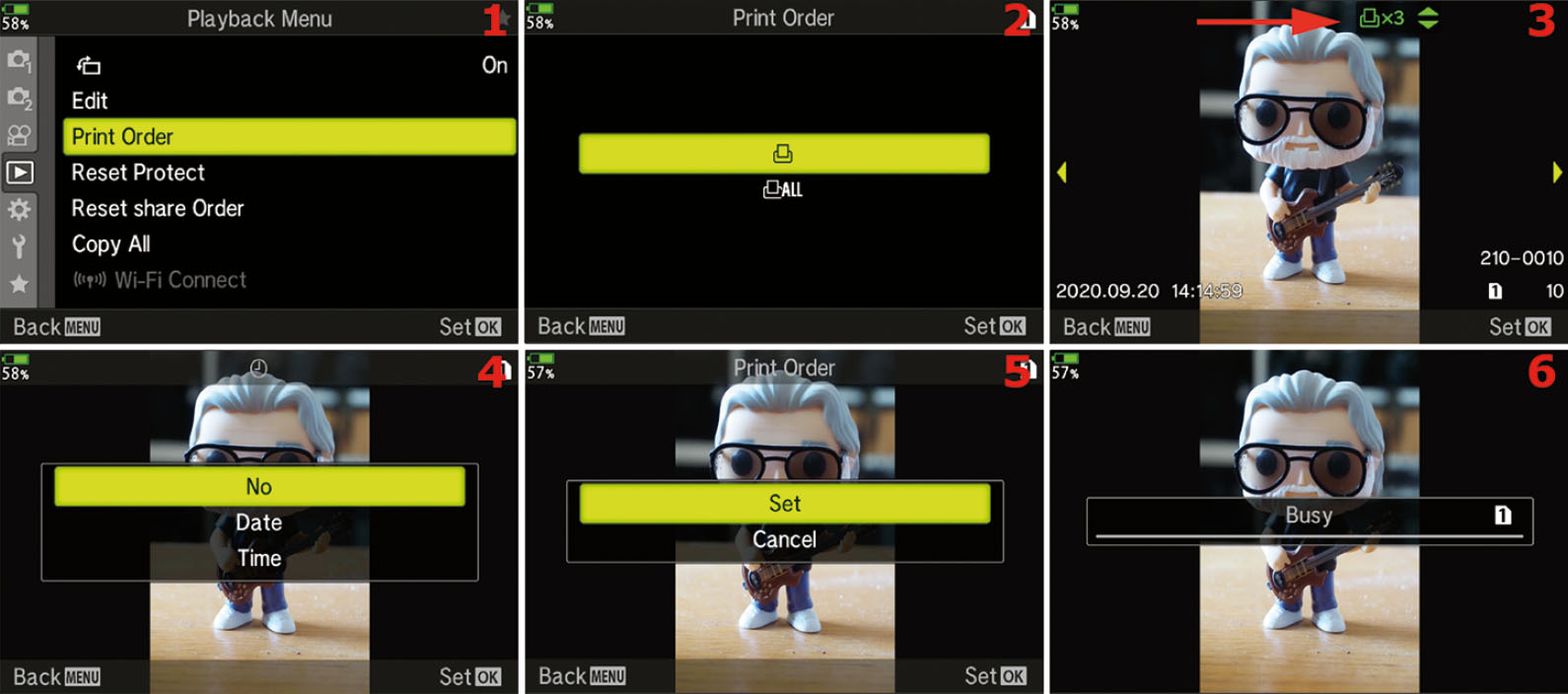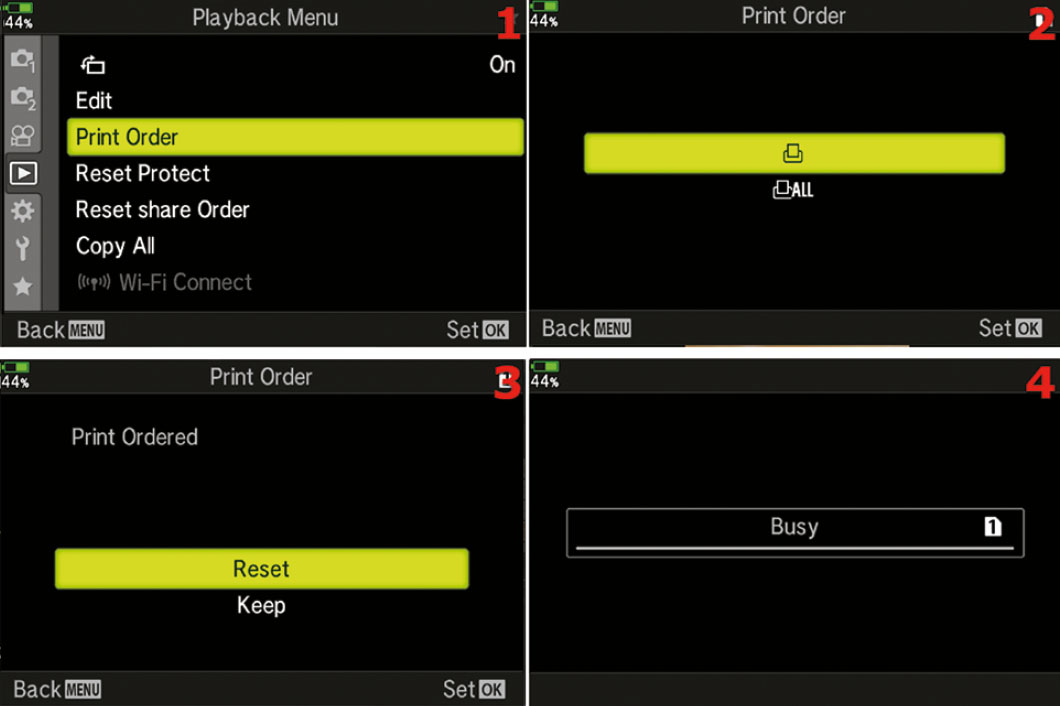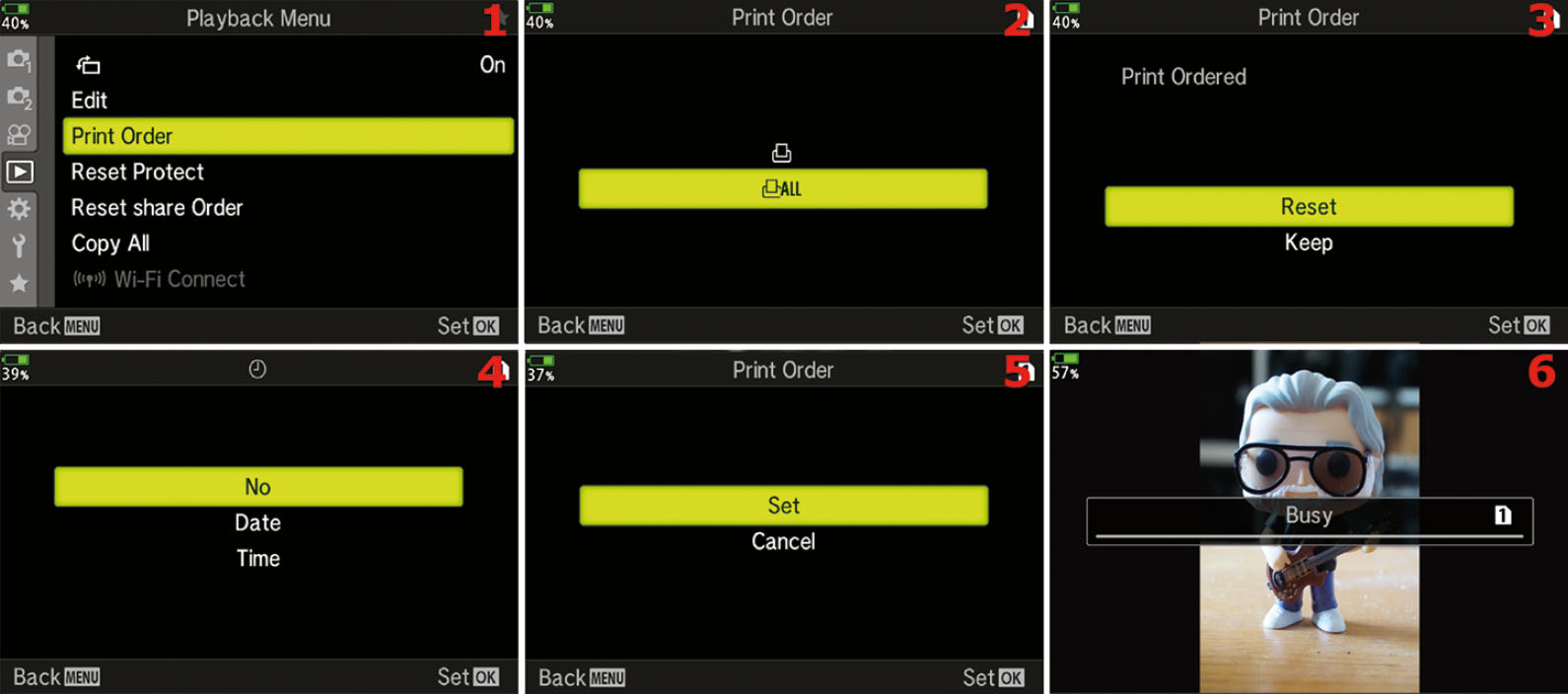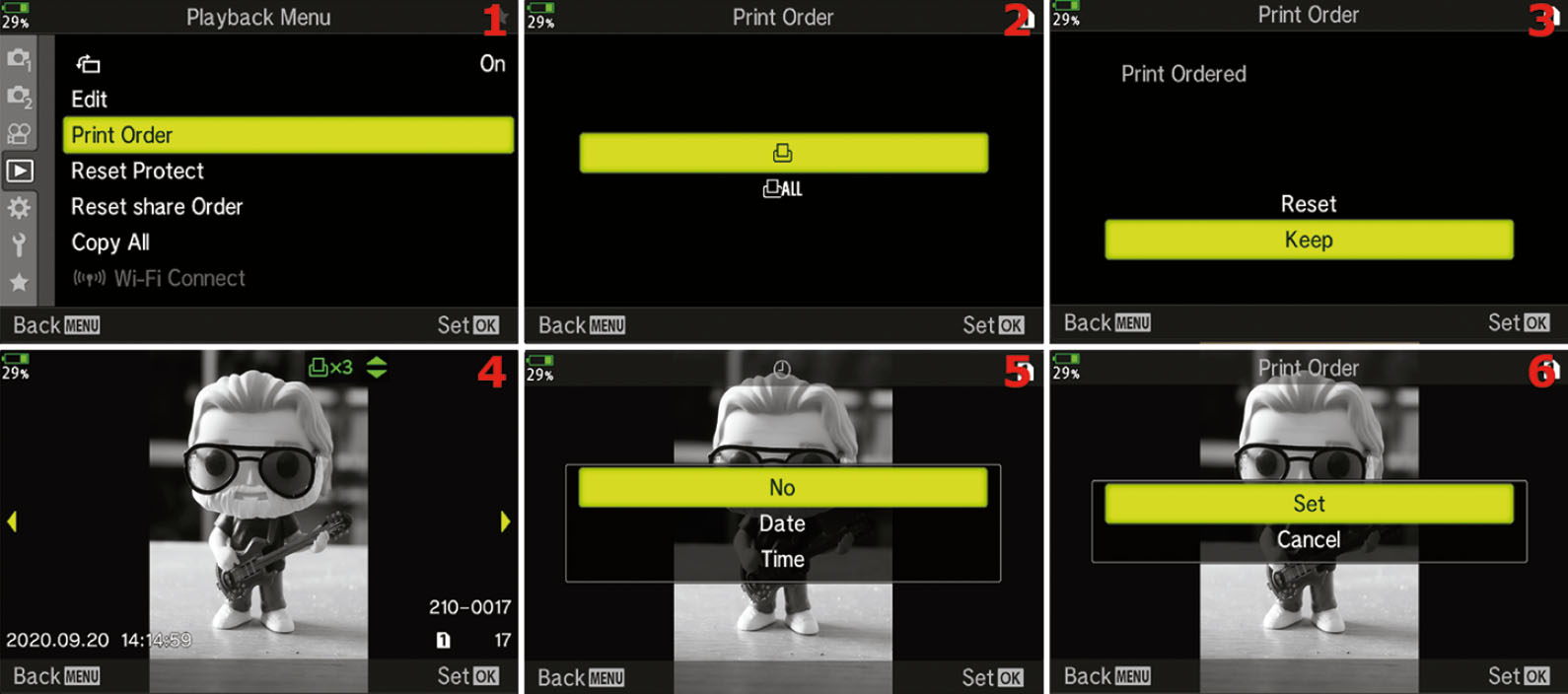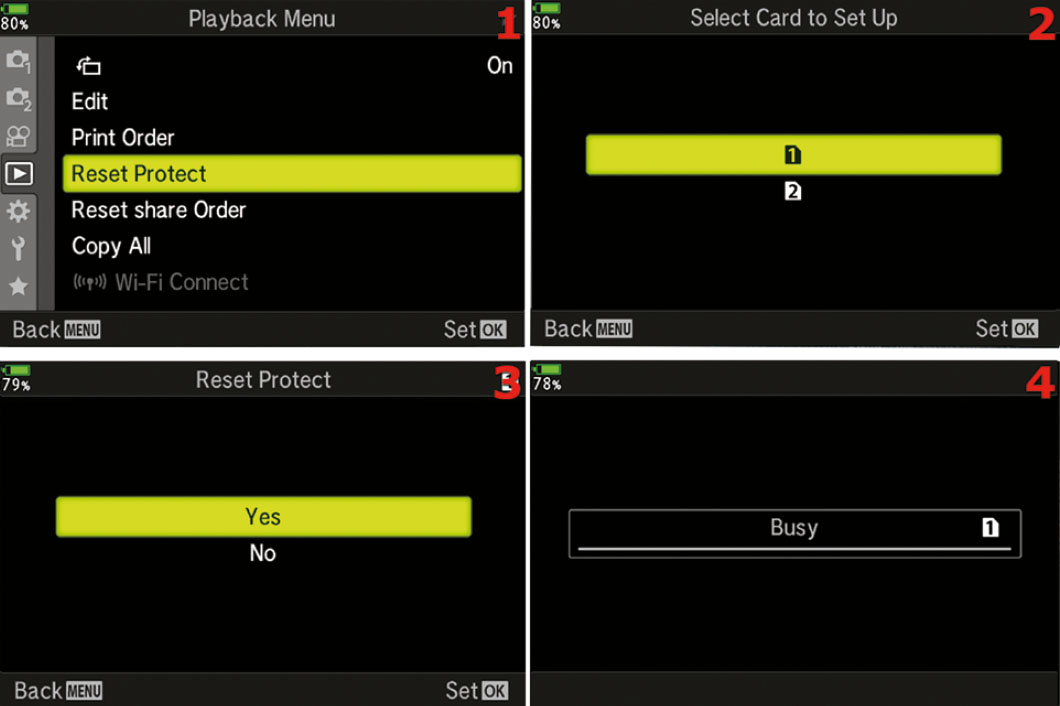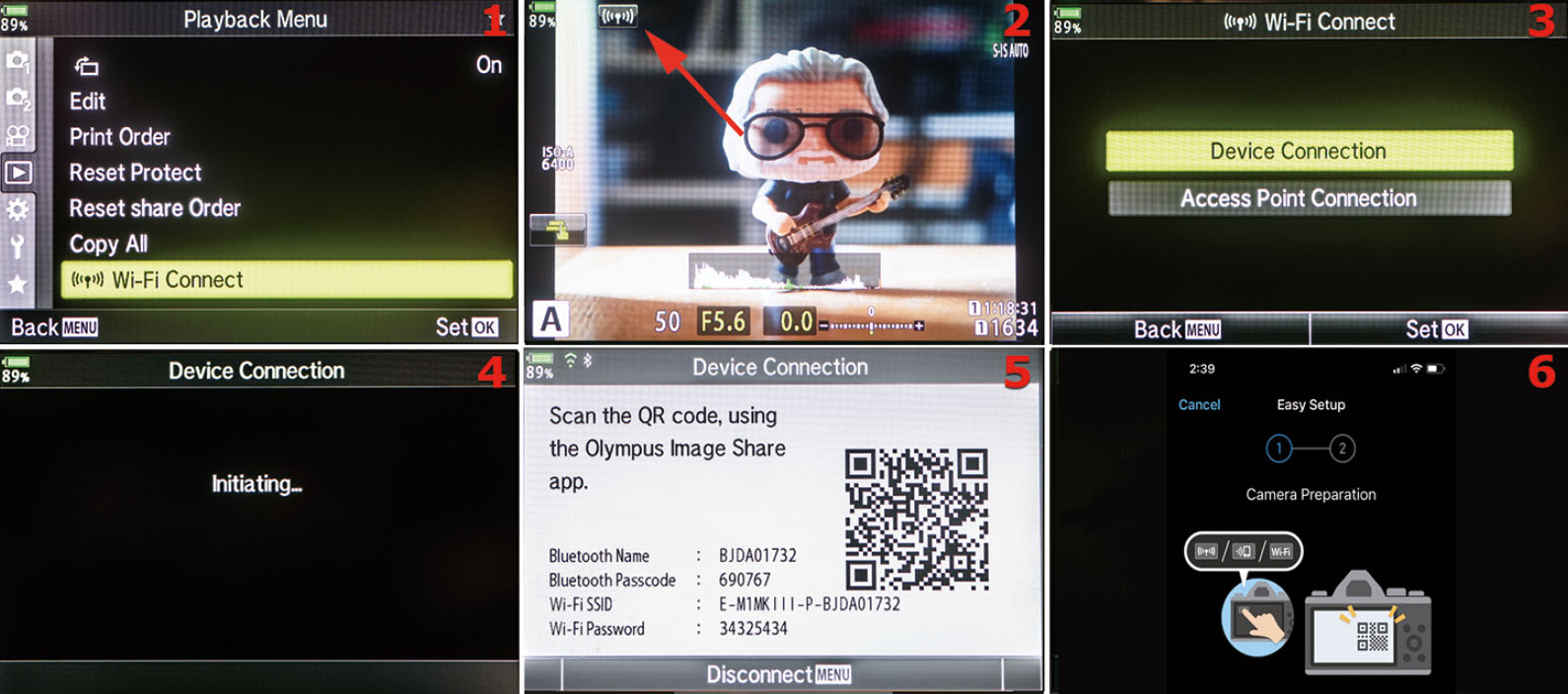06Playback Menu

Image © Alan Hess
The Playback Menu is the fourth system menu in this camera, and it is primarily used for working with images you’ve already taken. In this chapter, we will discuss all of the options in the Playback Menu, which includes Image Rotation, Editing, Print Order, Reset Protect, Reset share Order, Copy All, and Wi-Fi Connect.
Let’s consider each of the seven functions in full detail (figure 6.1).
Figure 6.1: The Playback Menu
[Image Rotation]
[Image Rotation] allows you to choose if an image taken in portrait (vertical) orientation is displayed upright or rotated onto its side on the camera monitor.
Figure 6.2: Choose how a vertical image will display on the camera monitor
Use these steps to choose how a vertical image will display:
- Select the [Image Rotation] symbol from the Playback Menu and scroll to the right (figure 6.2, image 1).
- A small menu with On and Off choices will open (figure 6.2, image 2). If you want a vertical image to display as shown in figure 6.2, image 3, choose On. If you want it to be rotated onto its side, as shown in figure 6.2, image 4, choose Off. Press the OK button to lock in your choice.
Settings Recommendation: I leave this function set to On so the image on the monitor will be easier to review as I scroll through all my images. The E-M1III displays an image on the monitor for only about one-half second, unless you change the image review timeout setting in Setup Menu > Rec View (page 480). I leave Rec View set to one-half second (0.5sec) so it won’t delay my ability to take the next picture.
If you change the Rec View default to a longer time, you may want to leave [Image Rotation] Off so you can review your image on the monitor in the same direction you were holding the camera when you took the picture.
Edit
If you don’t like working with images on the computer, or if you are on a tour in the wilds and don’t have a computer available, you can still do basic in-camera image processing. You can take an original RAW or JPEG image, modify it in various ways, then save it as a new JPEG image.
Sel. Image
Sel. Image (Select Image) is the first of the two image editing tools. We will consider the second—Image Overlay—later in this chapter.
There are four ways to modify images with the Sel. Image tool: RAW Data Edit, JPEG Edit, Movie Edit, and [Voice Annotation]. Let’s examine each of these. The options available will depend on the type of file selected.
RAW Data Edit
RAW Data Edit allows you to convert a file from RAW to JPEG in-camera. If you prefer to shoot in RAW for maximum image quality, and quickly need a JPEG for some reason, you can create one without using a computer. Here are the conversion types:
- Current: You will choose a RAW image on the monitor and the camera will create a JPEG image using whatever camera settings are currently set on the camera.
- Custom1 and Custom2: These two functions allow you to select individual changes to image exposure settings. The camera will then convert a RAW image into a JPEG image with the settings you choose. You can save the Custom1 or Custom2 settings and use them later.
- ART BKT: You can choose a RAW file, apply one or more of the camera’s Art Modes to it, then save it as a JPEG. This is a good way to apply an Art Mode to an image after the fact.
- No: Cancel image editing with Sel. Image.
The RAW Data Edit function works only with RAW files. There is a separate JPEG Edit function for JPEG files, which we will discuss in the upcoming JPEG Edit subsection. If there are only JPEG images on the memory card, the RAW Data Edit choice will be grayed out and unavailable.
There are 11 conversion factors to consider when you convert a file from RAW to JPEG. When you use the Current and Custom RAW Data Edit functions, you will notice that each has a different way to configure the 11 settings.
RAW to JPEG conversion factors
- JPEG quality setting (e.g., LSF, LF, MN)
- Picture Mode (e.g., Vivid, Natural, Muted)
- White Balance (e.g., Sunny, Cloudy, Incandescent)
- Exposure compensation (±3.0 EV)
- Shadow Area Adjust (Sh; ±7 steps)
- Midtone Area Adjust (Mid; ±7 steps)
- Brighten Area Adjust (Hi; ±7 steps)
- Image Aspect Ratio (e.g., 4:3, 16:9, 3:2)
- Noise Filter (i.e., Low, Std, High)
- Color Space (i.e., sRGB, Adobe RGB)
- Keystone Compensation (swing and tilt correction)
Let’s examine each of the RAW to JPEG conversion types: Current, Custom1 and Custom2, and ART BKT.
Current
This form of RAW (ORF) to JPEG conversion uses the camera’s current settings as a guide to conversion. These 11 settings are listed in the previous RAW to JPEG conversion factors list. Before you start the RAW Data Edit in Current mode, you must configure your camera settings for converting a file to JPEG.
After you have adjusted each of these items, you will execute the following steps to convert the image from RAW to JPEG.
Figure 6.3: Converting RAW to JPEG with Current camera settings (steps 1–4)
Use these steps to convert a RAW file on the memory card into a new JPEG file, which will have a new file number and show up as the last image on the memory card:
- 1. Choose Edit from the Playback Menu and scroll to the right (figure 6.3, image 1).
- 2. Choose Sel. Image from the Edit menu and press the OK button (figure 6.3, image 2).
- 3. The camera will display the images on the memory card, along with the format of each image (figure 6.3, image 3). Scroll through the images with the Arrow Pad until you find the RAW file you want to convert. Press the OK button to select the image.
- 4. Choose RAW Data Edit from the menu and press the OK button (figure 6.3, image 4). [Note: The camera will display a menu with both RAW Data Edit and JPEG Edit if an image has been taken in a RAW + JPEG format (e.g., LF+RAW).]
Figure 6.4: Converting RAW to JPEG with Current camera settings (steps 5 and 6)
- 5. Figure 6.4 begins where figure 6.3 ends. Select Current from the menu (figure 6.4, image 1). This tells the camera to use its current settings (see the RAW to JPEG conversion factors on page 267 to convert the file from RAW to JPEG. Press the OK button to continue, and you will briefly see a Busy screen (figure 6.4, image 2).
- 6. Next you decide whether the image looks okay on the camera monitor with the current settings applied (figure 6.4, image 3). If you think it looks fine, select Yes and press the OK button, which will make a new JPEG file while a Busy screen is displayed (figure 6.4, image 4). If you want to adjust the image further, select No and start over with new camera settings.
Figure 6.5: Converting RAW to JPEG with Current camera settings (step 7)
- 7. Figure 6.5 begins where figure 6.4 ends. The camera gives you a preview of the conversion, which hasn’t yet been saved to the memory card. A menu with Reset and No choices will appear (figure 6.5, image 1). If you select Reset, the camera will abandon the current conversion and jump back to the screen shown in figure 6.4, image 1, so you can start over at step 5. If you select No—which, ironically, means you do want to save the newly converted JPEG image—the camera will save the JPEG to a new file name as the last image on the memory card. The new JPEG image will appear on the monitor with the new file name displayed (figure 6.5, image 2, red arrow).
Custom1 and Custom2
The two Custom RAW Data Edit modes let you choose 11 factors for conversion. Unlike the Current RAW Data Edit mode discussed in the previous subsection, which used current camera settings for the conversion, the Custom functions allow you to adjust individual settings before you convert your image from RAW to JPEG.
The 11 settings you can adjust are shown in the RAW to JPEG conversion factors list (page 267). These are the same 11 functions used by the Current method. The difference between the Current and Custom RAW Data Edit settings is that the camera automatically saves the Custom settings so you can use them later. If you use the Custom function again without changing the settings, the camera will use your previous settings.
There are two Custom settings: Custom1 and Custom2. Configuring them works exactly the same way, so we will use only Custom1 as an example. Remember that Custom1 and Custom2 can be configured with different settings and you can reuse them later. Maybe you will use one Custom setting to convert RAW images to high-quality JPEGs and the other to convert RAW images to smaller JPEGs for online use.
Note: Pressing the Movie button at any time while you configure any of the 11 conversion factor settings will give you a Preview Update of what the image will look like after conversion. The Movie button is on top of the camera—just behind the Shutter button, next to the Exposure compensation button—and has a red dot. Preview Update will apply the current conversion settings, without saving the file, so you can see what the conversion looks like up to that point. You can test the conversion with each change if you want to. Each screen has a reminder that you can see a Preview Update (figure 6.7, image 2, bottom red arrow).
Now, let’s see how to use the Custom RAW Data Edit function.
Figure 6.6: Converting RAW to JPEG with Custom camera settings
Use the following steps to convert from RAW to JPEG with Custom RAW Data Edit’s 11 settings:
- 1. Choose Edit from the Playback Menu and scroll to the right (figure 6.6, image 1).
- 2. Choose Sel. Image from the Edit menu and press the OK button (figure 6.6, image 2).
- 3. The camera will now display the images on the memory card. Scroll through the images with the Arrow Pad until you find the RAW file you want to convert. The format of the image will be displayed on the monitor (figure 6.6, image 3, red arrow). The picture in our example is stored in both RAW and JPEG formats (LSF+RAW) on the memory card. Press the OK button.
- 4. The camera will display a menu with two choices: RAW Data Edit and JPEG Edit (figure 6.6, image 4). Since the picture in image 4 has both RAW and JPEG versions available (JPEG+RAW), both choices are available on the menu. Choose RAW Data Edit and press the OK button.
Figure 6.7: Choosing a Record Mode (image size and quality) for the converted JPEG
- 5. Figure 6.7 begins where figure 6.6 ends. You will see a menu with the two Custom settings. Select Custom1 or Custom2 and scroll to the right (figure 6.7, image 1).
- 6. Figure 6.7, image 2, shows the first of 11 screens we will use to configure the RAW to JPEG conversion settings, shown in the RAW to JPEG conversion factors list (page 267). The first setting is Record Mode (image size and quality). The items along the right side of the screen are headings, and their adjustments are shown at the bottom of the screen. Scroll up or down on the right side of the screen with the Arrow Pad to select a conversion setting, and scroll left or right on the bottom of the screen to make adjustments to that conversion setting. The Record Mode heading on the right (LN) has the following choices at the bottom of the screen: LSF, LF, LN, and MN (figure 6.7, image 2). Choose one of the Record Modes, such as LF (Large Fine JPEG) or LN (Large Normal JPEG), by scrolling left or right. (Press the Movie button for a Preview Update to see how the conversion will look so far. Do not press the OK button until you have completed all the changes you want to make. After you have chosen a Record Mode, scroll down one space on the right side of the screen to select a Picture Mode.
- 7. You can choose a Picture Mode to give a certain look to your new JPEG image (figure 6.8). There are 41 Picture Modes (this includes all the Art Modes) available on the bottom of the screen. The Natural Picture Mode is selected in figure 6.8. (See page 122, under the heading Picture Mode, for more information about Picture Modes.) Choose the Picture Mode you want to use for this conversion by scrolling left or right with the Arrow Pad. Press the Movie button for a Preview Update to see how the image conversion will look so far. Do not press the OK button unless you have completed all the changes you want to make. Scroll down to the next setting, White Balance (WB).
Figure 6.8: Choosing a Picture Mode for the converted JPEG
- 8. The White Balance (WB) setting (figure 6.9) lets you choose from 13 WB types, including eight standard settings (e.g., Auto, Sunny, Cloudy), four custom WB settings captured previously with a gray card, and a kelvin setting (2000K to 14000K). (See the chapter titled Custom Menu on page 422, under the White Balance (WB) heading, for more information about WB settings.) Choose the WB you want to use for this conversion by scrolling left or right with the Arrow Pad. I chose the WB Auto setting in figure 6.9. For WB settings that allow changes (e.g., CWB), press the Info button and scroll with the Arrow Pad to make changes. Press the Movie button for a Preview Update to see how the image conversion will look so far. Do not press the OK button unless you have completed all the changes you want to make. Scroll down to the next setting, Exposure compensation (+/−).
Figure 6.9: Choosing a White Balance setting for the converted JPEG
- 9. The Exposure compensation (+/−) setting lets you add or subtract light from the converted image in 1/3 EV steps, with maximum increments from −3.0 to +3.0 EV steps (figure 6.10). Choose an Exposure compensation value for this conversion by scrolling left or right with the Arrow Pad. You will see the number next to the +/− symbol change in 1/3 EV step increments. Press the Movie button for a Preview Update to see how the image conversion will look so far. Do not press the OK button unless you have completed all the changes you want to make. Scroll down to the next setting, Shadow Area Adjust (Sh).
Figure 6.10: Using Exposure compensation on the converted JPEG
- 10. The Shadow Area Adjust (Sh) setting lets you add or subtract light from the darker areas of the image in +/−7 steps (e.g., +1, +2, −1, −2) (figure 6.11). Choose a Shadow Area Adjust (Sh) value for this conversion by scrolling left or right with the Arrow Pad. You will see the number next to Shadow Area Adjust change one step at a time. Press the Movie button for a Preview Update to see how the image conversion will look so far. Do not press the OK button unless you have completed all the changes you want to make. Scroll down to the next setting, Midtone Area Adjust (Mid).
Figure 6.11: Choosing a Shadow Area Adjust value for the converted JPEG
- 11. The Midtone Area Adjust (Mid) setting lets you add or subtract light from the middle tones of the image in +/−7 steps (e.g., +1, +2, −1, −2) (figure 6.12). Choose a Midtone Area Adjust (Mid) value for this conversion by scrolling left or right with the Arrow Pad. You will see the number next to Midtone Area Adjust change one step at a time. Press the Movie button for a Preview Update to see how the image conversion will look so far. Do not press the OK button unless you have completed all the changes you want to make. Scroll down to the next setting, Brighten Area Adjust (Hi).
Figure 6.12: Choosing a Midtone Area Adjust value for the converted JPEG
- 12. The Brighten Area Adjust (Hi) setting lets you add or subtract light from the highlights of the image in +/−7 steps (e.g., +1, +2, −1, −2) (figure 6.13). Choose a Brighten Area Adjust (Hi) value for this conversion by scrolling left or right with the Arrow Pad. You will see the number next to Brighten Area Adjust change one step at a time. Press the Movie button for a Preview Update to see how the image conversion will look so far. Do not press the OK button unless you have completed all the changes you want to make. Scroll down to the next setting, image Aspect Ratio.
Figure 6.13: Choosing a Brighten Area Adjust value for the converted JPEG
- 13. The image Aspect Ratio setting (e.g., 4:3) lets you change the shape of the image (figure 6.14). You can change it from the normal Micro Four Thirds setting (4:3) to a different Aspect Ratio, such as a long and narrow HD view (16:9); the shape of most non-Micro Four Thirds digital images (3:2); square (1:1); or vertical Micro Four Thirds portrait mode (3:4). Choose one of the Aspect Ratio values for the conversion by scrolling left or right with the Arrow Pad. You will notice that the camera displays the pixel ratio for each Aspect Ratio (e.g., 5184 × 3888). To see how the change affects the image, press the Movie button for a Preview Update. Do not press the OK button unless you have completed all the changes you want to make. Scroll down to the next setting, Noise Filter (NF).
Figure 6.14: Choosing an image Aspect Ratio for the converted JPEG
- 14. The Noise Filter (NF) setting lets you select the strength of noise reduction for those higher-ISO images (figure 6.15). You can select from OFF, LOW, STD, and HIGH. It will be hard to see how the noise reduction system affects the image on the small camera monitor. You may want to experiment with noise reduction in advance so you can make a better choice during the conversion process. Most people leave Noise Filter (NF) set to Standard (STD). Press the Movie button for a Preview Update to see how the image conversion will look so far. Do not press the OK button unless you have completed all the changes you want to make. Scroll down to the next setting, Color Space (sRGB).
Figure 6.15: Choosing noise reduction for the converted JPEG
- 15. The Color Space (sRGB) setting lets you choose whether to use the generally noncommercial sRGB color space or the commercial Adobe RGB color space (figure 6.16). Most noncommercial photographers will leave Color Space set to sRGB because that works best for home, online, and superstore printing, and for display on social media sites and websites. If you are a stock photographer who submits images to a stock agency or are involved in other purely commercial photography endeavors where the images will be printed on an offset press, you will usually need to shoot with the Adobe RGB color space because it matches commercial CMYK color printing more closely. (See page 431 under the heading Color Space for more information.) Press the Movie button for a Preview Update to see how the image conversion will look so far. Do not press the OK button unless you have completed all the changes you want to make. Next, let’s discuss how to use Keystone Compensation during your RAW to JPEG conversion.
Figure 6.16: Choosing a Color Space for the converted JPEG
- 16. Keystone Compensation allows you to add corrections to images that have perspective distortion, such as when you take a picture of a building with a wide-angle lens and the building looks like it’s falling over backward. Keystone Compensation gives you swing and tilt controls, like you’ll find on an old-fashioned, film view camera. Swing allows you to move the left or right edge of a picture toward and away from you, and tilt allows you to tilt the top or bottom of the image toward or away from you. To use this function, select On using the arrow keys, then press the Info button when the screen shown in figure 6.17 is on the monitor. Then use the Front Dial to swing the left or right edges of the image toward or away from you, and the Rear Dial to tilt the top or bottom of the image. (Note: See Keystone Comp. on page 180 for more information on how this function works.) Now it’s time to finish the RAW to JPEG conversion with all of the custom settings applied. The camera saves your settings so you can make more conversions using the settings you just prepared. Press the OK button to start the final conversion process.
Figure 6.17: Using Keystone Compensation
Figure 6.18: Viewing a final Preview Update and then converting the image
- 17. The camera will display a final Preview Update of the image, with all your carefully crafted settings in place. You will also see a small menu with Yes and No choices (figure 6.18, image 1). If you choose No the camera will revert to the image selection screen and you will have to start over. If you choose Yes the camera will execute the final conversion from RAW to JPEG.
- 18. During the conversion, a Busy screen with a progress bar will display (figure 6.18, image 2). When the progress bar is complete, you will have one final decision to make before the image is saved to the memory card.
- 19. Before you save the new JPEG image to the memory card, the camera opens a menu with Reset and No options (figure 6.18, image 3). If you select Reset, the camera will not save the new image. Instead, it will jump back to the beginning of the conversion. If you select No, the camera will save the new JPEG image under a new file name as the last JPEG image on the memory card. The final converted image will be displayed on the camera monitor with a new file name (figure 6.18, image 4, red arrow).
Now, let’s consider how to use the third type of RAW to JPEG conversion: converting to JPEG with an Art Mode.
ART BKT
The ART BKT function allows you to choose a single RAW image and create up to 41 JPEG images from it. Each image will automatically have a different Picture Mode or Art Mode applied to it, which is why the function has the letters BKT (bracket) in its name. In effect, you will be creating more than one JPEG image from a single RAW file, an Art Mode Bracketing (ART BKT) series.
The camera allows you to select all Picture Modes and Art Modes in the ART BKT function, not just the Art Modes, as the function name implies. (We discussed each of the Picture and Art Modes in the chapter titled Shooting Menu 1, under the subheading Picture Mode (page 122). For more information on each mode, see the corresponding subsection.)
If you are unsure which Picture Modes—Basic, Creative, or Art—you want to use, and if you would like to make a test image with each one, you can do it with ART BKT. Or if you want to make a single JPEG image with only one of the special Art Mode looks applied (e.g., Pop Art, Grainy Film, Gentle Sepia), you can do that, too.
Now, let’s examine how to create a RAW to JPEG conversion with multiple JPEG files, each with a specific Picture Mode or Art Mode effect applied.
Figure 6.19: Creating a RAW to JPEG ART BKT conversion (steps 1–6)
Use the following steps to make a RAW to JPEG conversion using one or more of the camera’s available Picture or Art Modes:
- 1. Select Edit from the Playback Menu and scroll to the right (figure 6.19, image 1).
- 2. Choose Sel. Image from the Edit menu and press the OK button (figure 6.19, image 2).
- 3. The camera will display the images on the memory card. Scroll through the images with the Arrow Pad until you find the RAW file you want to convert. The format of the image will be displayed on the monitor (figure 6.19, image 3, red arrow). The picture in our example is stored in both JPEG and RAW formats on the memory card. Press the OK button to select the image.
- 4. The camera will display a menu with multiple choices (since the picture has both RAW and JPEG versions available): RAW Data Edit and JPEG Edit (figure 6.19, image 4). Choose RAW Data Edit and press the OK button.
- 5. You will now see the RAW Data Edit menu and a choice of conversion types (figure 6.19, image 5). Highlight ART BKT and scroll to the right.
- 6. The ART BKT list of available modes will now appear, with the Art Modes (e.g., Pop Art, Soft Focus) at the top (figure 6.19, image 6). When this screen first appears, quite a few modes will already be checked. Only 7 of the 41 available modes are visible on the screen in image 6—you must scroll down to see the rest. If you do the ART BKT conversion with more than one Picture or Art Mode checked, the camera will create a JPEG image for each of the checked items. To check or uncheck a mode simply highlight it and press the OK button, and you will see the check mark appear or disappear. Check whichever modes you want to use, and then scroll to the left with the Arrow Pad or press the Menu button once to get back to the previous screen (figure 6.20, image 1) where you will execute the ART BKT conversion.
Figure 6.20: Creating a RAW to JPEG ART BKT conversion (final steps)
- 7. Now you will execute the conversions and create a new JPEG file for each Picture and Art Mode you selected in step 6. Make sure ART BKT is still highlighted and press the OK button to start the conversions (figure 6.20, image 1).
- 8. You will see a Busy screen with a progress indicator while the camera creates the new JPEG images (figure 6.20, image 2). The more images you are converting, the longer the Busy screen will be displayed. At the right end of the progress indicator, you can see the symbol for the memory card to which the files are being written (1 or 2). Allow some time if you checked a lot of Picture or Art Modes in step 6.
- 9. When the conversion is complete, the camera will display one of the images from the conversion, along with a menu that has two choices: Reset and No (figure 6.20, image 3). If you select Reset at this point, the camera will return to the screen shown in figure 6.20, image 1, which stops the conversion and lets you select a different Picture Mode from the ART BKT list. If you choose No, the camera will save the new JPEG image(s) to the memory card and display the last image in the series—or a single image if you chose only one Picture or Art Mode—on the monitor (figure 6.20, image 4). If there are multiple JPEGs in the conversion, you can scroll to the left with the Arrow Pad to see each of the images with the Picture or Art Mode applied.
Now, let’s examine the next type of image editing, JPEG edit.
JPEG Edit
The JPEG Edit function lets you make in-camera changes to your existing JPEG image files and then save them as new files. It works only with JPEG files. There is a separate RAW Data Edit function for RAW files, which we discussed in the previous RAW Data Edit subsection (page 266).
When you select and modify a JPEG file, the original file is not changed. A new modified JPEG file is created and stored with a new file name as the last image on the memory card. If you don’t like using computers to modify files, or if you immediately need a modified JPEG, the JPEG Edit function is quick and easy to use.
There are nine adjustments for JPEG images, which are very different from the edits that can be made to a RAW file:
- Shadow Adj: This setting automatically adjusts the shadows of an image to reveal more image data. Use it to brighten mildly underexposed images or to open the shadows on well-exposed images.
- Redeye Fix: The camera attempts to remove red eye when the subject has that strange-looking, red-eye reflection caused by flash.
- [Crop]: You can crop the image up to four ways: both horizontal and both vertical sides.
- Aspect: This setting changes the aspect ratio from the standard Micro Four Thirds 4:3 ratio to 3:2, 16:9, 1:1, or 3:4.
- Black & White: You can convert an image to a grayscale, black-and-white image.
- Sepia: The camera will give your image an old-fashioned sepia, brown-toned look.
- Saturation: This setting allows you to increase or decrease the color saturation by using a sliding +/− indicator.
- [File Size]: You can choose from three smaller file sizes: 1280×960 (1.2 MP), 640×480 (0.3 MP), and 320×240 (0.075 MP).
- e-Portrait: This setting makes skin tones smoother and adds translucence for an anti-aging effect.
Adjusting a JPEG image is different from cumulatively setting the conversion factors on a RAW file, as we did in the previous subsection. You can apply a single adjustment to a JPEG image, which then produces a new image. If you want to apply an adjustment to that image, you can, but it will slowly start to degrade the image quality. To maintain maximum quality, think of these adjustments as effects that you can apply to different images, not as cumulative steps that you’ll apply to one JPEG image.
Figure 6.21: Choosing a JPEG image and starting the JPEG Edit steps
Use the following steps to choose an image for modification and to make any of the available changes:
- Select Edit from the Playback Menu and scroll to the right (figure 6.21, image 1).
- Choose Sel. Image from the Edit menu and press the OK button (figure 6.21, image 2).
- The camera will display the images on the memory card. Scroll through the images with the Arrow Pad until you find the JPEG file you want to convert. The format of the image will be displayed on the monitor (figure 6.21, image 3, red arrow). Press the OK button to select the image.
- You will see a menu with four choices: RAW Data Edit, JPEG Edit, Movie Edit, and the [Voice Annotation] microphone symbol (figure 6.21, image 4). You can tell that this image is not a RAW file because it is labeled LSF in image 3, and in image 4, the RAW Data Edit choice is grayed out and unavailable as is the Movie Edit choice. If this image had been shot in a JPEG+RAW format, the memory card would have both files and you could edit either the RAW file or the JPEG file. Choose JPEG Edit and press the OK button.
The images in figure 6.21 are the first four screens for the next nine subsections (figures 6.22 to 6.30). Each of the upcoming adjustments will begin where figure 6.21 leaves off.
Shadow Adj (Opening the Shadows)
Figure 6.22: Opening the shadows
- Figure 6.22 begins where figure 6.21 ends. Choose Shadow Adj from the JPEG Edit menu and press the OK button (figure 6.22, image 1).
- You will briefly see a Busy screen with a progress bar as the camera adjusts the shadows (figure 6.22, image 2).
- When it is done, you will see the adjusted image with a menu that has Yes and No choices (figure 6.22, image 3). To make the Shadow Adj modification permanent, select Yes. The camera will apply the adjustment and save the new JPEG image with a new file name. To cancel and start over, select No.
Redeye Fix (Removing Red Eye)
Figure 6.23: Removing red eye
- Figure 6.23 begins where figure 6.21 ends. The Redeye Fix adjustment removes glowing red eyes that occur when the subject’s retinas reflect flash light back into the lens. Choose Redeye Fix from the JPEG Edit menu and scroll to the right (figure 6.23, image 1).
- If the camera does not detect a human face, it will display an error message (figure 6.23, image 2). Either the picture has no people in it, their faces are too small, or their faces are at a bad angle. If you see this screen, the camera cannot work with the image. If the camera does detect a human face, you will see the screen shown in image 3.
- The camera will now find and remove red eye from the image. A Busy screen and progress bar will stay on the monitor for a few moments while face detection and red-eye removal takes place (figure 6.23, image 3). The camera will attempt to remove red eye even from images in which there is no red eye.
- Since the camera can detect a human face in the example picture, you will see a menu with Yes and No choices (figure 6.23, image 4). Choose Yes to save the new JPEG image with red eye removed, or No to cancel and start over.
[Crop] (In-Camera Image Cropping)
Figure 6.24: Cropping the image
- Figure 6.24 begins where figure 6.21 ends. You can crop an image to remove unwanted surroundings and show only the most important part of the picture. Select [Crop] from the JPEG Edit menu and press the OK button (figure 6.24, image 1).
- Rotate the Front or Rear Dial to see a series of preset image crop sizes. Figure 6.24, image 2, shows the largest horizontal crop, and image 3 shows the largest vertical crop. There are also two smaller crop sizes that you can see when you rotate either Dial. Select one of the crop sizes, use the Arrow Pad to move the green crop rectangle to the desired location, and press the OK button to execute the crop. You cannot change the crop sizes so this is very limiting.
- You will see an unsaved preview of the cropped image on the monitor (figure 6.24, image 4). The screen will have a menu with Yes and No choices. Select Yes to save the new image, or No to cancel and start over.
Aspect (Changing Image Proportions)
Figure 6.25: Adjusting the Aspect ratio
- Figure 6.25 begins where figure 6.21 ends. The aspect ratio is the relationship of the picture’s horizontal sides to its vertical sides. The Aspect ratio setting allows you to choose from several preset image sizes. The basic Micro Four Thirds (4:3) ratio can be cropped to one of four additional ratios. Choose Aspect from the JPEG Edit menu and press the OK button (figure 6.25, image 1).
- A menu will open with several aspect ratio choices: 3:2, 16:9, 1:1, and 3:4 (figure 6.25, image 2). Choose the aspect ratio that best fits the subject matter and press the OK button.
- A green aspect ratio frame will surround the subject (figure 6.25, image 3). Use the Arrow Pad buttons to move the green aspect ratio frame to the desired position, then press the OK button to execute the aspect ratio change. I selected the 3:2 aspect ratio. This converts the image into the slightly longer and narrower 3:2 format used by many DSLR cameras (e.g., Nikon). If you do not like the aspect ratio you chose, simply press the Menu button and the camera will return to the screen shown in figure 6.25, image 2, and you can choose a different one. After you have chosen a ratio, positioned the frame, and are ready to execute the change, press the OK button.
- You will see an unsaved preview of the new image on the monitor (figure 6.25, image 4). The screen will have a menu with Yes and No choices. Select Yes to save the new image, or No to cancel and start over.
Black & White (Converting to Grayscale)
Figure 6.26: Converting an image to Black & White
- Figure 6.26 begins where figure 6.21 ends. Black & White conversion lets you change a color image into a grayscale (monochrome) picture. Choose Black & White from the JPEG Edit menu and press the OK button (figure 6.26, image 1).
- You will see an unsaved preview of the new image on the monitor (figure 6.26, image 2). The screen will have a menu with Yes and No choices. Select Yes to save the new image, or No to cancel and start over.
Sepia (Converting to Antique Brown Tones)
Figure 6.27: Converting an image to Sepia
- Figure 6.27 begins where figure 6.21 ends. Sepia conversion lets you change a color image to a monochrome image with brown tones instead of gray tones. Choose Sepia from the JPEG Edit menu and press the OK button (figure 6.27, image 1).
- You will see an unsaved preview of the new image on the monitor (figure 6.27, image 2). The screen will have a menu with Yes and No choices. Select Yes to save the new image, or No to cancel and start over.
Saturation (Changing Image Color Strength)
Figure 6.28: Changing the color saturation
- Figure 6.28 begins where figure 6.21 ends. The Saturation setting lets you change the strength of the colors in the image. Choose Saturation from the JPEG Edit menu and press the OK button (figure 6.28, image 1).
- You will see small before (left) and after (right) versions of the selected image (figure 6.28, image 2). There will be a sliding scale with a green dash that indicates the current Saturation position. You can make the colors stronger (more saturated) by moving the slider up, or weaker (less saturated) by moving the slider down, on a scale of 10 steps. I moved the slider five steps toward increased Saturation (figure 6.28, image 2, red arrow). Use the up and down buttons on the Arrow Pad to change the Saturation level. I then reduced the Saturation level (figure 6.28, image 3, red arrow). You can see the differences in Saturation on the right sides of images 2 and 3. When you are happy with the Saturation level, press the OK button.
- You will see an unsaved preview of the new image on the monitor (figure 6.28, image 4). The screen will have a menu with Yes, Reset, and No choices. Select Yes to save the new image. Select Reset to move the slider back to the middle of the scale so you can make new adjustments. Select No to cancel and start over. When you are done, press the OK button to create and save the new JPEG image.
[File Size] (Downsizing an Image)
Figure 6.29: Downsizing an image
- Figure 6.29 begins where figure 6.21 ends. Normal 4:3 images from your E-M1III have 5184 × 3888 megapixels. That is equivalent to a 20 MP image, which is much too big to display on social media sites and can even be too large to email. You can quickly make a smaller JPEG by using the [File Size] function. Select the [File Size] symbol from the JPEG Edit menu and press the OK button (figure 6.29, image 1).
- You will see a menu of file sizes: 1280×960 (1.2 MP), 640×480 (0.3 MP), and 320×240 (0.075 MP). There is also a No option, which cancels the operation. Any of these smaller file sizes can be emailed or used on social media sites. Select the file size you want to use and press the OK button, or select No to cancel (figure 6.29, image 2).
- A Busy screen with a progress indicator will display on the camera monitor while the image is converted to the smaller size (figure 6.29, image 3). Then the camera will display the new, smaller JPEG image, which is saved as the last image on the memory card. To validate that the camera reduced the size of the new image to 640×480, I pressed the Info button to switch to the image detail/histogram screen. Instead of 5184×3888, the image shows a size of 640×480 (figure 6.29, image 4, red arrow).
e-Portrait (Smoothing Skin Tones)
Figure 6.30: Smoothing skin tones
- Figure 6.30 begins where figure 6.21 ends. The e-Portrait function converts a normal JPEG portrait into a new portrait with smoother skin tones. Choose e-Portrait from the JPEG Edit menu and press the OK button (figure 6.30, image 1).
- You will see a small menu with Yes and No selections. Choose Yes to start the conversion process, or No to cancel and start over (figure 6.30, image 2).
- A Busy screen with a progress indicator will display during the conversion process (not shown). When the conversion is done, a before-and-after screen will appear (figure 6.30, image 3). This screen stays on the monitor for a few seconds, then the camera displays the new image that has been saved to the memory card (figure 6.30, image 4).
We have now worked our way through all of the options in the JPEG Edit menu.
Movie Edit
The Movie Edit function allows you to trim a movie from the front or back end. You will thereby shorten the movie, keeping only the desired frames in the middle of the movie.
This function is a duplicate of the function we covered in chapter 5 on Movie Editing after a video recording. It takes several pages to describe; therefore, instead of duplicating material here, please refer to the Movie Edit heading and description on page 214.
Now let’s examine the final form of image editing, [Voice Annotation].
[Voice Annotation]
The [Voice Annotation] setting lets you add a voice message to an image file while you view it on the camera monitor.
How can voice annotation be useful for a professional, or an enthusiast, for that matter? Let’s say you are shooting a beautiful landscape on the Blue Ridge Parkway and you add a voice annotation to the first image in the series with important information from a sign so you can later create an accurate caption. Or maybe you are photographing the bride’s grandmother, Myrtle May, at a wedding and you want to remember her name later when you are preparing the wedding album. Voice annotation is an easy way to take notes about an image, without carrying anything extra.
The voice file is a standard WAV format that can be played by your computer, tablet, smartphone, or camera. That makes sense because you want to store the sound file with the image file so you can reference it years later.
When you transfer images to your computer, do not overlook copying your sound files along with the image files. The sound files will have the same names as the image files, except the three-character extension is different. For instance, if you record a sound file for an image with a filename of P4000250.JPG, the linked sound file will have the filename of P4000250.WAV.
Let’s see how to make a voice recording for any image on the memory card.
Figure 6.31: Making a [Voice Annotation] for an individual image
Use these steps to make a [Voice Annotation] for any image you can view on your camera monitor:
- 1. Select Edit from the Playback Menu and scroll to the right (figure 6.31, image 1).
- 2. Choose Sel. Image from the Edit menu and press the OK button (figure 6.31, image 2).
- 3. Images will be displayed on the camera monitor. Use the Arrow Pad buttons to scroll back and forth until you find an image to which you want to add a voice annotation (figure 6.31, image 3). After you have found the image, press the OK button.
- 4. I chose a JPEG image, and the camera displayed a menu with a microphone symbol, the [Voice Annotation] setting (figure 6.31, image 4). Highlight it and press the OK button.
Figure 6.32: Making the voice recording
- 5. Figure 6.32 starts where figure 6.31 ends. Now you will record the actual voice annotation. Before you record your voice, you need to know the location of the Stereo microphone pickups on your camera so you can talk directly into them for the best reception. Look at the Olympus logo on the viewfinder bump on the front of your camera. On either side of the bump you will see a small hole. Each of the holes is a Stereo microphone pickup (left channel and right channel). The best recording will be made if you talk with your mouth near the top of the camera. Just act as if the Hot shoe is a microphone, and your voice will be picked up. In figure 6.32, image 1, you can see the recording menu that appeared when you completed step 4. Select Start from the menu, and press the OK button to start recording the voice annotation.
- 6. Figure 6.32, image 2, shows the screen that will be visible while you are recording a voice annotation. A red REC symbol will appear at the bottom of the screen along with a timer (red arrow). The red card access symbol will blink in the top-left corner of the screen while you make the recording. Even though the timer seems to indicate that you could record for a long time, you are limited to 30 seconds. When you are done recording, press the OK button to stop. If you keep talking longer than 30 seconds, the camera will cut you off.
- 7. Nothing obvious appears on the screen when you are done making a voice recording. The camera continues to display the image for which you were making the voice annotation (figure 6.32, image 3). If you want to hear the recording, press the Playback button and the annotation will play back through the Speaker to the left of the Menu button on the back of the camera. Note: You can record new voice annotations for different images by pressing the OK button on a new image, selecting the microphone symbol (similar to figure 6.31, image 4), then starting again at step 5.
- 8. A green musical note symbol will appear on the camera monitor for any image that has a voice annotation (figure 6.32, image 4, red arrow). As soon as the camera displays an image with a musical note symbol on the monitor, the recording will play. You can adjust the volume with the Arrow Pad buttons: up increases the volume, and down decreases it. A volume indicator scale will appear on the right side of the monitor when you adjust the volume (not shown).
Settings Recommendation: Recording a voice annotation through the Edit menu is really the long way around. You can record a voice recording any time you see an image on the camera monitor by pressing the OK button and selecting the [Voice Annotation] microphone symbol (review steps 5–8).
Image Overlay
Image Overlay allows you to take two or three images, vary their transparency, and overlay them into one image. This is an easy way to do something like add a picture of the moon to a nighttime landscape image.
This works differently than Multiple Exposures because there is no Auto Gain function to keep the backgrounds from overwhelming multiple subjects in different parts of the image. Instead you use a transparency adjustment to vary the transparency of each image in the overlay.
The effectiveness of this method will vary greatly depending on how complex the images are. Let’s examine how it works and see how you might use it to combine two or three images.
Figure 6.33: Creating a three-image overlay (steps 1–4)
Use the following steps to start combining images:
- 1. Choose Edit from the Playback Menu and scroll to the right (figure 6.33, image 1).
- 2. Select Image Overlay from the Edit menu and press the OK button (figure 6.33, image 2).
- 3. Choose 2Images Merge or 3Images Merge from the Image Overlay up/down menu, depending on whether you want to combine two or three images (figure 6.33, image 3). I chose 3Images Merge.
- 4. The screen will display images from the memory card (figure 6.33, image 4). Although it shows both JPEG and RAW images, only RAW images can be selected for overlaying. The word RAW will appear in the top-left corner of each available image. JPEG images are dimmed and cannot be selected. Choose each image you want to use with the green selection frame and press the OK button, which will place a red check mark in the top-right corner of the image. You can see that I have selected two images because they have red check marks. The third image I want to use in the overlay is surrounded by the green selection frame. As soon as you select the final image, the camera will start creating the overlay. You won’t see the check mark for the final image. When the overlay process begins, a Busy screen appears with a progress bar. When the overlay is done, the screen shown in figure 6.34, image 1, appears.
Figure 6.34: Creating a three-image overlay (steps 5–7)
- 5. You will see the before images across the bottom of the screen and the combined image as a larger single image on top (figure 6.34, image 1). The red arrow points to an up/down menu with a range from x0.1 to x2.0. You adjust the transparency of each image with the up and down buttons of the Arrow Pad. Each before image has this up/down menu that ranges from x0.1 to x2.0 and controls the transparency of the corresponding image. You can see that I set each image to the lowest setting of x0.1 so the combined backgrounds do not obscure the different plants. At first I was confused because my after image was close to pure white, and I couldn’t see any of the individual plants. That’s because each image contains both a plant and a bright sky background. Each plant is positioned differently, but in the overlay the backgrounds of the other two images completely hid them. After I lowered the transparency of all the images, the three plants appeared. Although you see three plants in the after image, you also see the backgrounds of each one, with the transparency lowered to let the other pictures show through. When you change the transparency level, allow a little time after each change for the camera to respond. After you have the transparency adjusted the way you want it on each picture, press the OK button.
- 6. The camera will display the overlaid image and a menu with Yes and No choices (figure 6.34, image 2). Choose Yes to finish creating the new JPEG image or No to cancel and start over. Press the OK button.
- 7. A Busy screen will appear with a progress bar (figure 6.34, image 3). When it is done, the finished JPEG image will appear, which is saved with a new file name as the last image on the memory card (figure 6.34, image 4).
Settings Recommendation: The final picture in figure 6.34, image 4, is not very colorful or useful. You may be able to come up with a better example of how to overlay two or three images than plants and a white background; however, if you are really into overlaying images, you might want to consider Multiple Exposure for better-looking images.
Print Order
When you create a Print Order on your memory card, you can insert the card into a Digital Print Order Format (DPOF) printing device, such as a photo kiosk at a superstore or a DPOF-compatible inkjet printer. The kiosk or printer will then print the order without your camera. If you don’t like to post-process images or work with computers, you can print images without doing much more than inserting a memory card into a compatible printing device. It’s convenient even if you do like computers.
There are three things you need to know about the Print Order function:
- How to print copies of a few selected images on the memory card.
- How to print one copy of each image on the memory card.
- How to clear a Print Order from the memory card.
There can be only one Print Order at a time on a memory card. If you are the curious sort, you will find the Print Order in a folder named MISC on the memory card. The camera creates that folder and saves the Print Order inside it. The Print Order is held in a small file named AUTPRINT.MRK, which can be read by all DPOF-compatible printing devices.
Now, let’s examine each of the Print Order methods.
Selected Image(s) Print Order
This Print Order method lets you scroll through the images on your memory card. As each image is displayed on the camera monitor, you can select the number of prints (up to 10) you want to make for that image. Let’s see how it works.
Figure 6.35: Creating a Print Order for individual images
Use these steps to create or update a Print Order for individual images.
- Choose Print Order from the Playback Menu and scroll to the right (figure 6.35, image 1).
- Select the printer symbol from the Print Order menu to create a Print Order for individual images. Press the OK button (figure 6.35, image 2).
- If there is an existing Print Order on the memory card, an additional screen will appear. Instead of figure 6.35, image 3, you will see the screen shown in figure 6.36, image 3, which allows you to Reset or Keep the current Print Order. If you Reset it, the camera will remove the current Print Order. If you Keep it, the camera will start displaying pictures, as seen in figure 6.35, image 3, and it will leave any current Print Orders intact. In effect, you will updating an existing Print Order.
- The current image will be displayed. Use the adjustable counter to select the number of copies you want of the current picture (figure 6.35, image 3, red arrow). Scroll up and down with the Arrow Pad to select a number from 0 to 10. I selected 3 copies. Scroll left or right to choose other images and select the number of copies you want. Leave any images you do not want printed set to 0. When you have selected the number of copies for each of the images you want to print, press the OK button to lock in the numbers.
- The camera will now display the Date and Time screen (figure 6.35, image 4). This allows you to have either the shooting Date or Time written on the print. Select Date for the shooting date, or Time for the shooting time, or No for neither. Press the OK button to lock in your choice.
- The camera will switch to the final Print Order menu where you can Set the order or Cancel it (figure 6.35, image 5). If you select Set, the camera will display the Busy screen (figure 6.35, image 6). The progress indicator will advance, and the red card symbol will blink in the top-left corner of the monitor as the camera writes the Print Order to the memory card. If you select Cancel, the selections you made will be ignored and the camera will return to the Playback Menu.
If you simply want to clear the Print Order from your memory card, it is a straightforward process, as we will discuss in the next subsection.
Clearing a Print Order
You may want to remove an old Print Order after you print your images. To do so, use the Print Order Reset function.
Figure 6.36: Resetting a Print Order for individual images
Use these steps to clear an old Print Order from a memory card:
- Choose Print Order from the Playback Menu and scroll to the right (figure 6.36, image 1).
- Select either of the two symbols from the Print Order menu. I chose the top symbol for individual images (figure 6.36, image 2). The following instructions work the same way for the All selection, which we will discuss in the next subsection (All Print Order). Press the OK button with one of the Print Order items selected.
- You will now have two choices: Reset and Keep (figure 6.36, image 3). If you select Reset, the camera will immediately reset, or delete, the current Print Order. The Busy progress indicator will show the progress, and the red card activity symbol will flash in the top-left corner of the camera monitor (figure 6.36, image 4). If you choose Keep, the camera will leave the existing Print Order on the memory card and return to the images in the existing Print Order, with the number of copies you selected, so you can make modifications.
Now, let’s see how to select a Print Order in which every image on the card is set to print one copy.
All Print Order
All Print Order allows you to create a Print Order that will cause a DPOF printing device to make one copy of each image. After we explore how this works, we’ll take a look at how you can have the camera print more than one copy of selected pictures and one copy of the rest of the pictures.
Figure 6.37: Create or Reset a Print Order for all images
Use the following steps to create or reset a Print Order for all images on the current memory card:
- Choose Print Order from the Playback Menu and scroll to the right (figure 6.37, image 1).
- Select the bottom symbol from the Print Order menu. It looks like a printer with the word All after it. This will cause one copy of each image on the memory card to be printed. Press the OK button (figure 6.37, image 2).
- If there is an old Print Order on the memory card, the screen shown in image 3 will appear and you will need to choose either Reset or Keep. Choosing Reset will immediately delete the old Print Order. Choosing Keep will leave the old Print Order in place only if you select Cancel in step 5 (figure 6.37, image 5). Otherwise, it makes absolutely no difference whether you choose Reset or Keep; the old Print Order will be overwritten anyway.
- You can choose whether a Date or Time stamp is applied to the printed image (figure 6.37, image 4), or just select No then press OK.
- If you select Set, the camera will create a new Print Order, effectively deleting any older print orders. Selecting Set always recreates the Print Order with one copy selected for each image. Select Cancel if you don’t want to create this new print order or Set if you want to create a new one. You will see a Busy screen and a progress bar if you create a new Print Order (figure 6.37, image 6). The Busy screen will show the progress of the images being marked for printing. When the Print Order has been created the camera will return to the Playback Menu.
Increasing the Number of Copies on a Few Images in an All Print Order
As you know, an All Print Order sets the number of printed copies to 1 for each image on the memory card. But what if you want more than 1 printed copy of a few images and 1 printed copy of the rest? There is a way to increase the number of copies to more than 1 for selected images within the All Print Order. Here’s how.
Figure 6.38: Increasing the print count for a few images in an All Print Order
Use the following steps to increase the print count on selected images within the All Print Order:
- First you must create a new All Print Order by using the steps accompanying figure 6.37. The next few steps assume that a new All Print Order is on the card with 1 selected as the print count for each image on the memory card.
- Choose Print Order from the Playback Menu and scroll to the right (figure 6.38, image 1).
- Select the top symbol from the Print Order menu, which allows you to select the number of copies for individual images (figure 6.38, image 2). Press the OK button.
- Select Keep from the Print Order menu (figure 6.38, image 3). Press the OK button to continue. You have just told the camera that you want to keep the All Print Order you created in step 1. Now we will modify it!
- The camera will display the images that are currently on the memory card, and each one will have the number of printed copies set to 1 because we are looking at the results of an All Print Order. Scroll back and forth with the Arrow Pad keys until you find an image for which you want to increase the number of printed copies. I picked the black-and-white photo of the bobblehead. I want 3 copies of this image, so I increased the print count to 3 by scrolling up on the Arrow Pad (figure 6.38, image 4). You can keep scrolling back and forth to find other images you want more prints of and increase the numbers. When you are done increasing the numbers, press the OK button to modify the All Print Order. Now you will get one copy of most of the images, and you’ll get the number of copies you chose for the rest of the images.
- On the Date and Time stamp screen, choose Date, Time, or No (neither) and press the OK button (figure 6.38, image 5).
- The final screen allows you to confirm the modification of the existing All Print Order. Select Set and press the OK button (figure 6.38, image 6). The camera will show the Busy screen progress indicator with a flashing red card icon in the top-left corner (not shown). When it’s done, the card is ready to insert into a DPOF-compatible device to print your custom All Print Order. Select Cancel and press the OK button to cancel the process.
Settings Recommendation: Print Orders can be quite useful in some circumstances. You may want to print a few images, so you create a Selected Image(s) Print Order and make your prints. Or you may have shot an event and would like to deliver the images to your client so they can have them printed right away. You could create an All Print Order (and modify it if necessary) and then give the memory card to your client. They can go straight to a DPOF printing device and plug in the memory card. The DPOF device will do the rest.
Reset Protect
If you have previously set an image protection lock on any of the images on a memory card, you can cancel the protection lock on all images on the memory card with the Reset Protect function.
Adding Image Protection
When you press the OK button while viewing an image on the camera monitor, you will see a menu for editing that image. The menu has a key symbol, which means you can add protection to an image. Select the key symbol and press the OK button to set protection on that image.
After you apply protection, the image will be displayed on the monitor with a green key (lock) symbol in the top-right corner, and it won’t be deleted during an All Erase operation (Setup Menu > Card Setup > [Card Slot] > All Erase). We discussed image protection in the chapter titled Screen Displays for Camera Control, on page 93, under the subheading Protecting Images. For more information on adding protection, please review that subheading.
It’s easy to remove image protection, as we’ll see in the next subsection.
Removing Image Protection
To remove image protection, you simply choose Reset Protect from the Playback Menu and answer Yes to the query.
Figure 6.39: Removing image protection with Reset Protect
Use the following steps to remove image protection from all protected images on the memory card:
- Select Reset Protect from the Playback Menu and scroll to the right (figure 6.39, image 1).
- Select the memory card you want to remove image protection from if you have two memory cards inserted (figure 6.39, image 2).
- A menu with Yes and No choices will appear (figure 6.39, image 3). Choose Yes to reset the image protection or No to cancel.
- Press the OK button to remove protection. A Busy screen with a progress bar will appear briefly (figure 6.39, image 4), and then the camera will return to the main screen of the Playback Menu.
Settings Recommendation: This function resets all protected images at the same time. If that is too drastic, you can remove protection from individual images by following these steps:
- Display an image with the green key protection symbol on the monitor.
- Press the OK button and select the key symbol from the menu.
- Scroll up or down with the Arrow Pad until the green key symbol disappears.
- Press the OK button to remove the protection.
This process is the opposite of adding protection. Adding protection is discussed in the chapter titled Screen Displays for Camera Control, on page 93.
Reset Share Order
If you have previously created a share order for any images on the camera, you can simply reset it here. To reset the share order, you simply choose Reset share Order from the Playback Menu, pick the memory card to apply the reset to and answer Yes to the query.
Figure 6.40: Resetting the share order
Use the following steps to reset the share order on a selected memory card:
- Select Reset share Order from the Playback Menu and scroll to the right (figure 6.40, image 1).
- A menu allowing you to pick the memory card will appear if both card slots are being used. Pick the card to use and press OK (figure 6.40, image 2).
- A new menu will open with Yes and No choices (figure 6.40, image 3). Choose Yes to reset the share order or No to cancel.
- Press the OK button to Reset the share Order and a Busy screen with a progress bar will appear briefly (figure 6.40, image 4), and then the camera will return to the main screen of the Playback Menu.
Settings Recommendation: This function resets the share order on a selected memory card, making it really easy to just start over without having to go through the images one at a time. I use it after I have transferred the images I wanted so as not to get duplicate images in the share order.
Copy All
The Copy All function allows you to copy all of the images saved on one memory card (e.g., Slot 1) to the other memory card in the camera (e.g., Slot 2). It provides a quick way to back up important images. Let’s see how to copy images from one card to the other.
Figure 6.41: Copying all images from one card to the other
Use the following steps to copy all the images on one memory card to the other memory card in the camera:
- Highlight Copy All on the Playback Menu and scroll to the right (figure 6.41, image 1).
- Choose the source and destination memory cards (1→2 or 2→1), where the card slot on the left is the source and the card slot on the right is the destination (figure 6.41, image 2). Our example shows that we are copying all of the images on the memory card in slot 1 to the memory card in slot 2 (1→2). Press the OK button to make your selection.
- Select Yes to copy all images from the chosen source card to the destination card, or select No to cancel. Press the OK button to start copying the images.
- Copying a large number of images from one card to the other may take considerable time, several minutes at the minimum. During the copy process a Busy screen with a progress indicator will be displayed (figure 6.41, image 3). The copy direction (1→2) is shown on the right end of the bar. When the progress bar reaches the right side of the screen, the operation is complete and the camera will return to the screen shown in figure 6.41, image 1.
Settings Recommendation: This is a very valuable function. You may use it to copy critical images to additional memory cards. If you are a commercial shooter, or an enthusiast, you will surely find reasons to use Copy All.
Wi-Fi Connect
The E-M1III has the ability to act as a Wi-Fi wireless access point. That means the camera can wirelessly communicate with your smartphone or tablet, which I’ll refer to collectively as a smart device. You can also connect directly with a personal computer using the Access Point Connection functionality and the Olympus Capture software. We will cover both methods here, starting with the Device Connection.
You can use the screen of your smart device as a remote monitor and control the camera directly from the device. You can transfer images wirelessly to your smart device for immediate use on social media sites, blogs, and websites.
There is a free Olympus app for both iOS (iPhone and iPad) and Android devices (OI. Share). Do a search for “Olympus Image Share” in your app store and download it to your smart device before you proceed with this section.
There are two parts to communicating with a smart device. First, you must enable Wi-Fi on the camera, then you must create a relationship between the camera and the device. Let’s examine the process.
Figure 6.42: Making a Wi-Fi connection to your smart device
Use the following steps to connect your camera to the Olympus Image Share (OI.Share) app:
- Figure 6.42, images 1 and 2, show two entry points to the Wi-Fi system. You will see image 2 when you are accessing the Wi-Fi system from the Live View screen instead of the Playback Menu. However, I wanted to show the alternate entry point (image 2, red arrow) so you can access it if you want to. You can touch the Wi-Fi icon on the touch screen, or you can select Wi-Fi Connect on the Playback Menu and scroll to the right. Either one of these screens will take you to the screen in image 3.
- Figure 6.42, image 3, shows the Device Connection or Access Point Connection screen. For now, we are going to use the Device Connection choice since that is the one that allows the camera and a smart device to communicate. The Access Point Connection is for connecting to a personal computer and will be covered next. Select Device Connection and press OK. After a few seconds, you will see the Device Connection (figure 6.42, image 4). Press the Info button to bring up the screen seen in figure 6.42, image 5, which allows you to scan the QR code from the OI.Share app to your device to initiate the connection. Open the app and tap on Easy Setup, located at the bottom of the app (image 6), then just follow the directions on the screen. It’s that easy. When you are done, press the Menu button on the camera to disconnect.
- To connect the camera to a personal computer, you will need to download the Olympus Capture software from the Olympus website, then launch the program and follow the directions. Since the software is updated regularly and each computer is slightly different, follow along with the instructions when you launch the software, but be warned, you will need a USB cable to attach the camera to the computer to finish the pairing.
Author’s Conclusion
This chapter covered different ways you can view and use images from your Olympus E-M1III.
Our next chapter, Custom Menu, covers the dozens of functions you can customize on this camera. It is a primary reference chapter for many of the settings you will use when you configure buttons and dials on the camera. Although there are a lot of functions, you will be a master of your camera if you take time to carefully study the chapter.
Now, let’s customize our cameras!
